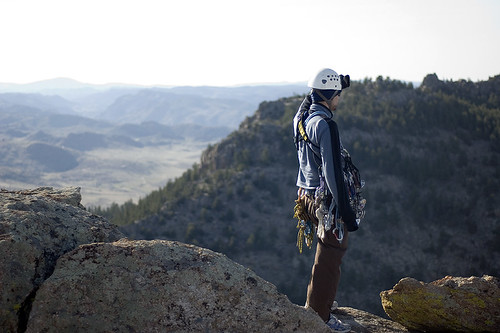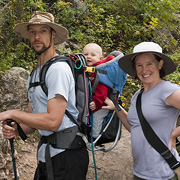How to climb Greyrock in 17 pitches
Mark and I decided in the last week or so that we want to try to climb the Grand Teton at the end of June. To warn our readers, the next several adventure write-ups on this blog are probably going to start with the words “As preparation for our up-coming climb of the Grand Teton…”
This weekend, we picked Greyrock as our training ground. We hiked the 3.5 mile long meadows trail to the base of the mountain. When we got to the bottom of the mountain, two parties were already climbing on top of each other on The Greatest Route. Another pair of climbers had just arrived, and seeing the log-jam decided to climb Barfy’s Favorite instead. We only knew of three routes to the top of the rock, so we wandered back to the “Chipmunks” area. There was a large group finishing up a top-rope on the first pitch of one of the three cracks. After they cleaned it, we started up the second part of our adventure for the day.
The last time we climbed Greyrock, we found ourselves on an easy, 5.6 route to the summit that Mountain Project calls Theodore. This time, we climbed the crack that started 10ft to the right, and managed to end up on a completely different route that was much more difficult.
Simon (5.9-) – This climb is usually done in four or five pitches and climbs the crack system to the right of Theodore. We started on the long, fun hand crack the other climbers were top roping. The second pitch was fun slabs and thin cracks up to a huge ledge under an extremely intimidating roof. The guidebook said the crux of the climb was this overhanging hand crack, and it looked horribly intimidating. In fact, when Mark got up to the roof, there was a new-looking sling around a chuck where it looks like another leader may have bailed.
Mark climbed up to the roof, pulled hard and made it over without too much drama. There were a few interesting moments as he jammed in a yellow cam at his waist without being able to see it, and then climbed up the slab to the right and set a belay quickly. I was actually very nervous when I made it up to the roof. The ground seemed very far below me, and that crack was long, and very steep.
But, I dug in, and pulled out a clean ascent. I even managed to yank out the seriously over-cammed pro that Mark had placed. And, after a few surprisingly fantastic fist-jams, one wild scream as I stood up on two jammed feet, and then a few moves of beautiful, exposed crack climbing, I was at the very nice belay ledge.
The rest of the climb went well. We did shorter pitches because the sun was out, the day was warm, and there were lots of good ledges to hang out on. I have been reading the new edition of John Long’s Anchors, and I evaluated each belay point with “WWJLD?” Only one was questionable, on the 5th or 6th pitch (I don’t remember), I found Mark in front of two widely spread cams, with a sling around a television-sized detached boulder. I asked Mark if the boulder was safe and he replied “Sure it is! See!” giving it a kick that rocked it back and forth on the ledge just a bit.
“Take off the sling!” I demanded. “If that thing falls, I don’t want to be attached to it!” Mark complied. He handed me the gear, grumbling about how his “death sling” wasn’t good enough for me.
We scrambled up to the top of the mountain at about 5:30p. There were still a few hikers around, one of whom was nice enough to give me a shocked “Where did you come from??” expression when I clambered up over the edge of a shear cliffline. I love that moment. We re-organized, enjoyed the view, and hiked down (this time we both had shoes). I was already exhausted and sore from the day, but we dug deep and hiked home, taking only an hour and half to descend the 2.5 miles back to our car. I had blisters from shoes that were too small, leg and back muscles in tight knots and knees that are still sore. But it was a good day, and only the beginning.






